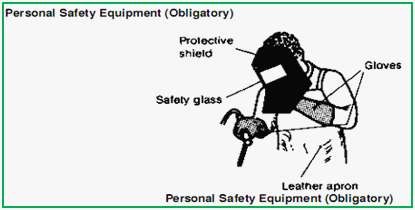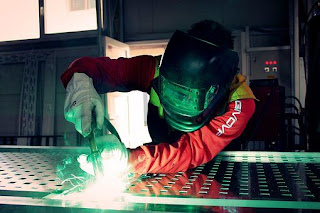Safety and Precautions during welding
As in any welding process, safety precautions are very important. All information relating to the safe operation of the welding equipment and process must be fully understood before beginning work.
A careless welder who does not observe some simple rules can cause a dangerous situation for everyone. The process of arc welding creates several hazards which must be guarded against.
If the welding machine has the characteristics of a transformer or a motor-generator design, electrical energy is required as primary power to operate it. Useful safety information can be found in the Owner’s Manual that comes with each item of welding equipment.

1. Electrical Shock:
Welders must be concerned about the possibility of electrical shock. It should be remembered that electricity will always take the path of least resistance. A welder should never weld while standing in water. If wet working conditions exist, certain measures should be taken. Such measures include standing on a dry board or a dry rubber mat.
Likewise, the welding equipment should not be placed in water. Gloves and shoes must be kept dry. Even a person’s perspiration can lower the body’s resistance to electrical shock.
1.1. Important Rules:
- Wear dry, hole-free insulating gloves and body protection;
- Insulate yourself from work and ground using dry insulating mats or covers;
- Disconnect input power or stop engine before installing or servicing this equipment;
- Properly install and ground the equipment including the welding table;
- When making input connections, attach proper grounding conductor first;
- Turn off all equipment when not in use;
- Do not use worn, damaged, undersized, or poorly spliced cables; Do not touch electrode if in contact with the work or ground;
- Use only well maintained equipment. Repair or replace damaged parts at once;
- Keep all panels and covers securely in place;
- Avoid poor connections, bare spots on cables or wet conditions.
2. Arc Rays:
- Several possible hazards exist due to the electric arc, infrared and ultraviolet rays.
- The light and rays can produce a burn more stronger than sunburn;
- Any exposed skin can be quickly burned by these rays.
3. Fumes and Gases:
- The welder must always keep good ventilation and not breathe the fumes;
- Use of protective screens or barriers to protect others from flash and glare;
- Should be always warning advices to others not to watch the arc;
- Approved standards safety glasses and side shields are recommended.
4. Fire or Explosion:
- Welding can cause fire or explosion;
- Protect yourself and others from flying sparks and hot metal;
- Welding should not be made where flying sparks can strike flammable material;
- Remove all flammables near of the welding arc;
- A fire extinguisher should all the time be available.
5. Flying Sparks:
- Flying sparks and hot metal can cause injury;
- Chipping and grinding cause flying metal. Remove slag after welds cool down;
- Wear protective clothing such as heat resistant jackets, aprons etc.;
- Do not wear clothing stained with oil and grease that may burn if ignited by the arc;
- To protect the feet, high top leather shoes are recommended.
we provide standard specifications for welding procedures for all welding process and Brazing. We offer Welder Procedure Specification, Welder Certificate Renewal Process, Procedure Qualification Record, Welder Qualification Testing, welder Training and Welder qualification services in Coimbatore,Trichy, Salem, Erode, Chennai.
Please feel free to reach us https://aqcinspection.com/training/ to learn more about any of the methods in detail.
Visit our technical and career updates at our Blog site https://advancedqualitycentre.blogspot.com . or


nice and great blog thanks for sharing>>
ReplyDeleteread more about..
Certified fabricated welding but it will give you the foundation you need to be successful. Welding school also teaches you how to be a good project manager.